How To Prepare Your Air Conditioner for the Winter Season


Government Rebates Now Available on Energy-Efficient Air Conditioners when Replacing your Gas Heater.
Preparing your air conditioner for the winter season ensures reliable performance, prevents costly damage, and extends the lifespan of your HVAC investment. As temperatures drop, moisture, debris, and freezing can compromise key components of your outdoor unit. In this guide on air conditioner preparation for winter, you’ll discover why winterising matters, when and how to perform DIY steps, expert advice on covering, cues to call Oz Air group’s professionals, specialised care for different system types, holistic HVAC maintenance tips, and spring startup best practices.
Why Is Winterising Your Air Conditioner Essential?
Winterising your air conditioner is the process of protecting its components against freezing temperatures, moisture accumulation, and debris buildup to maintain efficiency and prevent damage. By winterising, homeowners safeguard their outdoor condenser, refrigerant lines, and electrical connections, reducing the risk of rust, cracks, and rodents nesting. This preparation improves energy efficiency during winter heating and guarantees the unit is ready for the next cooling season.
What Are the Benefits of Proper AC Winter Preparation?
Proper AC winter preparation enhances system longevity, reduces repair costs, and promotes consistent performance.
- Extended Lifespan – Protective measures prevent corrosion and component fatigue, allowing units to last beyond the typical 10–15 years.
- Energy Efficiency – A clean, insulated system consumes less power when heating, lowering utility bills by up to 10–15%.
- Warranty Protection – Many manufacturers require seasonal maintenance to keep warranties valid.
- Improved Indoor Air Quality – Clearing debris and nesting materials before dormancy prevents allergens from circulating when the system restarts.
These benefits create peace of mind and align with Oz Air group’s commitment to reliable, efficient HVAC solutions.
Benefits of Regular HVAC Maintenance
Routine HVAC maintenance can extend the lifespan of a system by up to 50% and reduce energy usage by 5% to 15%. Additionally, studies indicate that approximately 85% of HVAC repairs are linked to a lack of proper maintenance, and regular upkeep can reduce the risk of breakdowns by up to 95%.
What Risks Do You Face If You Don’t Winterise Your AC?
Skipping winterisation exposes your condenser and refrigerant lines to freezing water, which can crack coils and pipe joints. Trapped moisture fosters rust on metal surfaces and encourages mold growth in accessible cavities. Debris and leaf accumulation restrict airflow, leading to overheating even in dormant mode. Unchecked, these risks translate into emergency repairs, compromised heating performance, and premature system failure. Recognising these hazards emphasises why winterising is a key preventative maintenance step.
Risks of Neglecting AC Winterisation
Failing to winterise an air conditioner exposes it to harsh weather, leading to potential damage from ice, rust, and debris. This neglect can result in frozen condenser coils, reduced efficiency, faster wear and tear, fluctuating refrigerant levels, and condensation damage, ultimately increasing the risk of costly repairs and premature system failure.
How Does Winterisation Improve Energy Efficiency and Indoor Air Quality?
Winterisation improves energy efficiency by sealing and insulating vulnerable parts of the outdoor unit, reducing heat loss from refrigerant lines, and preventing airflow obstructions around the condenser. Cleaner coils and protected components minimise compressor workload during heating cycles, boosting system performance. Indoor air quality benefits when pre-winter cleaning removes dust, pollen, and microbial buildup that might otherwise circulate during the next cooling season. This holistic approach supports healthier living environments and sustainable energy use.
When and How Should You Winterise Your AC Unit?
When Is the Best Time to Prepare Your Air Conditioner for Winter?
The best time to winterise your air conditioner is after the last cooling cycle in late fall, ideally when daytime temperatures consistently drop below 60 °F but before the first hard freeze. This window allows you to clean and inspect the unit while avoiding thermal stress. Scheduling maintenance during this period ensures the unit remains free of debris and moisture before winter storms arrive, protecting condensers and refrigerant lines until spring.
What Are the Key DIY Steps to Safely Shut Down and Clean Your AC?
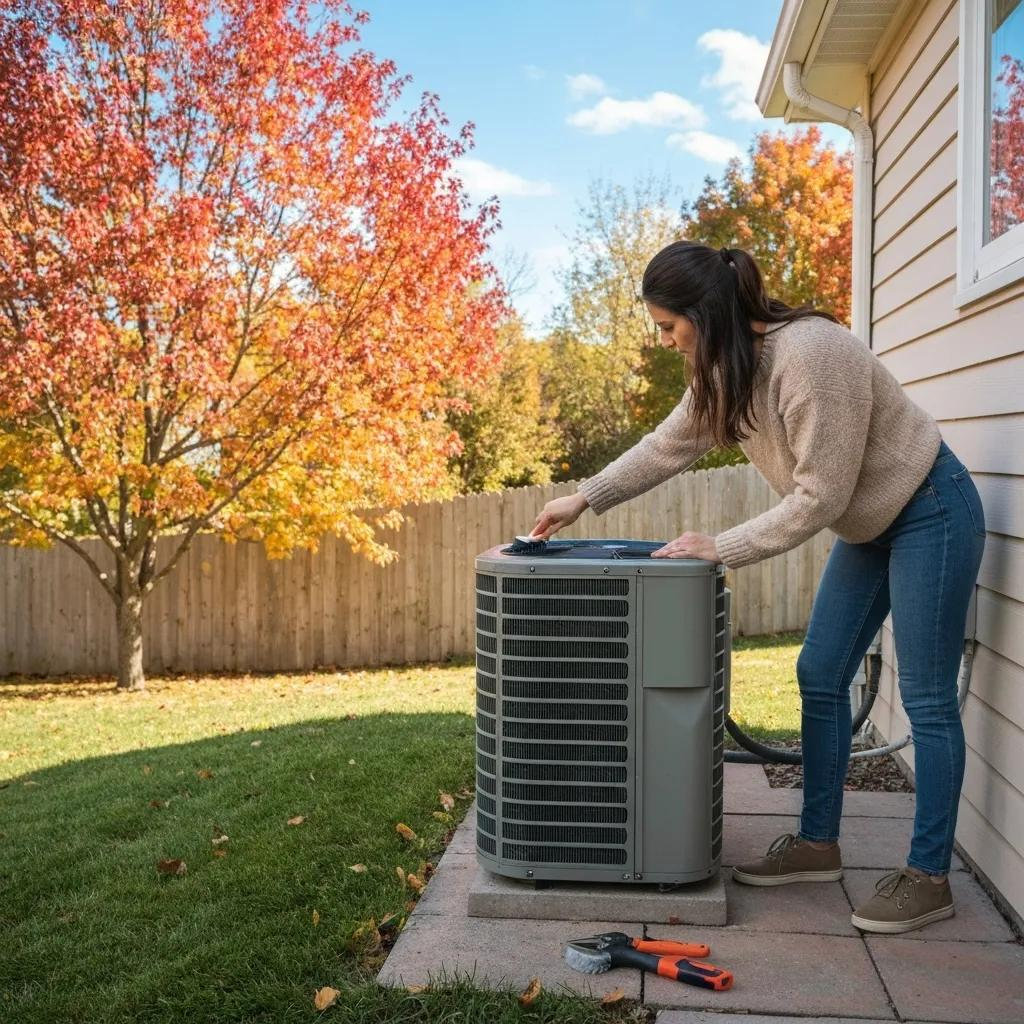
Before winter, homeowners should follow these steps to safely shut down and clean the outdoor unit:
- Power Off the System: Shut off electricity at the main breaker to eliminate risk of electric shock.
- Remove Debris: Clear leaves, twigs, and grass clippings from around and inside the condenser.
- Clean Coils and Fins: Use a soft brush or coil cleaner spray to remove dust and dirt deposits.
- Straighten Bent Fins: Gently realign fins with a fin comb to maintain proper airflow.
- Dry Thoroughly: Allow the unit to dry completely to prevent trapped moisture that leads to corrosion.
Completing these steps creates a clean, dry environment that deters rust, mold, and blockages, setting the stage for effective pipe insulation and covering.
How Should You Inspect Your AC Unit Before Winter?
A thorough inspection detects wear and potential issues before freezing temperatures cause failures. Check refrigerant lines for visible cracks or leaks and confirm insulation sleeves are intact and secure. Examine electrical connections and contactors for signs of arcing or corrosion. Inspect the condenser fan and motor housing for debris or damage. Identifying and addressing minor issues now prevents major breakdowns that could interrupt home heating and drive up repair costs.
How Do You Properly Insulate AC Pipes for Winter Protection?
Insulating your refrigerant lines maintains thermal integrity and prevents freeze damage. Below is a recommended approach:
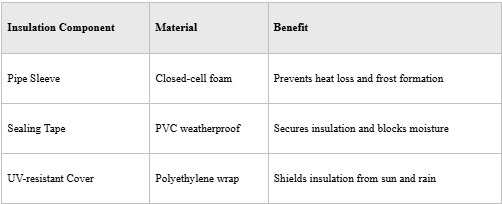
Wrapping lines this way stops condensation freeze, reduces stress on the compressor, and prolongs system life, ensuring reliable performance when spring startup arrives.
Should You Cover Your AC Unit in Winter? Oz Air group’s Expert Advice
What Types of AC Covers Are Recommended for Winter?
AC covers differ in material and design; choosing a breathable top-only cover balances protection and ventilation.
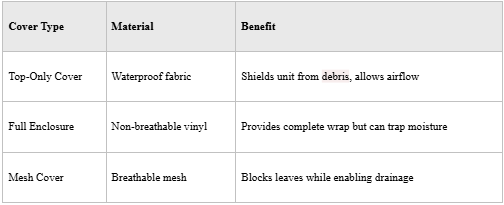
Considerations for Covering Outdoor AC Units in Winter
While covering an outdoor air conditioner might seem protective, fully enclosing the unit with non-breathable materials can trap moisture, leading to mold growth, corrosion of internal components, and restricted airflow. This can also create an inviting habitat for pests, potentially causing damage to wires and insulation. Experts often recommend breathable, top-only covers or no cover at all, depending on the climate.
When Is Covering Your AC Unit Beneficial or Harmful?
Covering your unit is beneficial when heavy leaf fall, pine needles, or ice buildup are likely to accumulate around the condenser. However, enclosing the entire unit under a non-breathable wrap can trap condensation, leading to rust and mold growth. For climates with light debris and moisture, relying on regular post-winter cleanup may suffice. Balancing cover use with proper drainage maintains protection without creating hidden moisture hazards.
How to Properly Install an AC Cover to Prevent Damage?
- Choose a Snug Fit: Select a cover that secures over the cabinet sides without sagging onto the base pan.
- Avoid Full Sealing: Drape the cover over the unit top, leaving sides open for ventilation.
- Secure Fasteners: Use built-in straps or bungee cords to anchor the cover against wind uplift.
- Check Drainage: Ensure water runoff exits freely, preventing pooling on the cover surface.
This method promotes airflow, prevents moisture entrapment, and aligns with best practices recommended by Oz Air group technicians.
When to Call a Professional for AC Winterisation Services?
What Does Oz Air group’s Professional AC Winterisation Include?
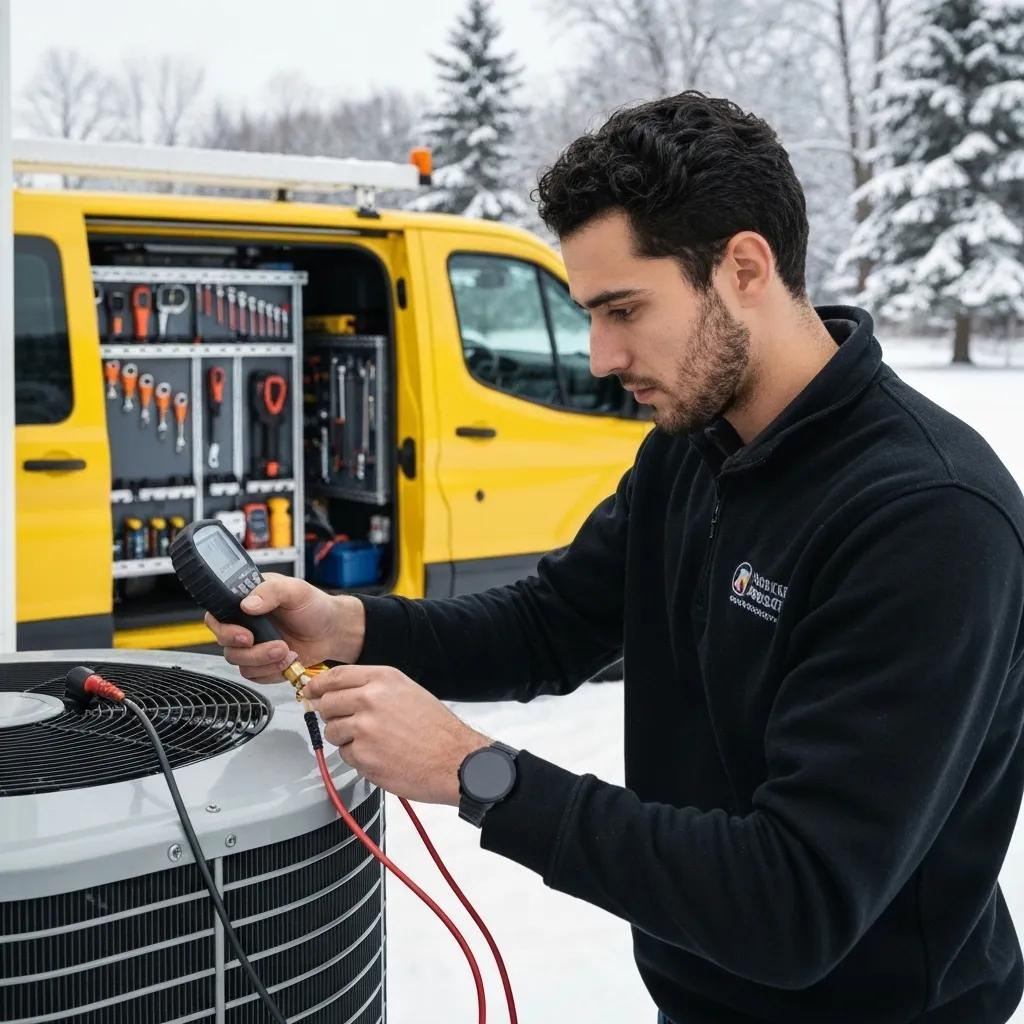
- Detailed system inspection covering refrigerant integrity, electrical connections, and mechanical components.
- Coil and fan cleaning using industry-grade solutions.
- Refrigerant line insulation replacement with premium materials.
- Application of breathable protective covers and drainage verification.
- Performance test to confirm operational readiness.
How Does Professional Winterisation Compare to DIY Maintenance?
DIY winterisation addresses routine cleaning and basic cover installation but may miss hidden leaks, improper insulation, or electrical wear. Professionals apply specialised tools and diagnostic equipment to detect subtle issues such as low refrigerant pressure or motor current irregularities before they escalate. While DIY is cost-effective for simple tasks, expert services deliver deeper protection, detailed reporting, and warranty compliance that DIY alone cannot match.
What Are the Cost and ROI of Professional AC Winterisation?
Investing in professional winterisation typically costs 5–10% of a full service tune-up but yields up to 40% savings in potential emergency repair fees. By preventing freeze-related damage, homeowners avoid compressor replacements ($1,000–$2,500) and coil repairs ($300–$800). The ROI comes from lower energy bills over winter, extended equipment lifespan, and reduced downtime, making professional winterisation a cost-effective maintenance strategy.
How to Prepare Different Types of AC Units for Winter?
How to Winterise Central Air Conditioning Systems?
Central air systems benefit from full cabinet cleaning, line insulation, and cover placement. Specialists recommend:
- Draining condensation pans and antifreeze loops.
- Sealing duct boots at the outdoor intake to prevent rodent entry.
- Testing zone dampers to maintain airflow balance.
What Are the Winterisation Steps for Window AC Units?
- Remove and Store: Detach the unit and store indoors if practical.
- Clean Filters and Coils: Use mild detergent and rinse thoroughly.
- Protect Casing: Cover exposed vents with shrink film or a vented cover indoors.
This approach stops moisture, dust, and pests from entering living spaces and extends unit life.
How to Prepare Mini-Split and Heat Pump Systems for Winter?
- Clear snow and ice within a 2 ft radius of the condenser.
- Replace or reinforce line set foam with closed-cell insulation.
- Test heating mode performance and recalibrate smart thermostats for optimal defrost cycles.
These measures support seamless transition between heating and cooling modes while protecting important heat exchange surfaces.
What Additional Winter HVAC Maintenance Should You Consider?
How to Adjust Thermostat Settings for Winter Efficiency?
Setting your thermostat to 68 °F during occupied hours and 60 °F when away maximises heating efficiency. Programming setbacks of 5–10 °F during sleep or absence can lower energy costs by up to 10%. Integrating a smart thermostat further enhances performance by learning household patterns and optimising heating cycles.
When and How Should You Replace Air Filters Before Winter?
Replacing or cleaning air filters in early November maintains proper airflow and indoor air quality. Choose filters rated MERV 8–11 to capture dust, pollen, and dander without overloading the blower. A fresh filter reduces system strain, which in turn supports efficient operation and extends motor life.
Why Is Ductwork Inspection Important for Winter HVAC Performance?
Leaky or poorly insulated ducts in unheated spaces can lose up to 30% of conditioned air before it reaches living areas. Inspect and seal visible duct joints with foil-backed mastic sealant, and add R-8 insulation to exposed runs. Proper duct maintenance improves heat delivery, lowers utility bills, and prevents ice dam formation on poorly conditioned surfaces.
What Should You Do After Winter? Spring AC Startup and Maintenance Tips
How to Safely Restart Your AC Unit in Spring?
- Remove Covers and Insulation: Clear all winter protective materials.
- Inspect for Damage: Check coils, fins, and wiring for winter-related wear.
- Turn Power Back On: Reactivate the breaker and thermostat.
- Test Cooling Mode: Run the system on a mild day to verify performance.
What Spring Maintenance Extends Your AC’s Lifespan?
- Cleaning evaporator and condenser coils.
- Lubricating motor bearings and checking refrigerant charge.
- Verifying drain line clearance and blowout.
These services reduce strain on all components, reinforcing the benefits of prior winterisation and setting the stage for efficient cooling.
How Does Proper Winterisation Impact Spring AC Performance?
Proper winterisation results in cleaner coils, intact insulation, and dry components are factors that improve airflow and compressor efficiency by up to 15%. This prep work minimises refrigerant leaks, reduces mechanical wear, and ensures that spring maintenance visits require only fine-tuning rather than major repairs, translating into consistent comfort and lower operating costs.
Maintaining your air conditioner year-round with these expert winterisation and spring startup strategies ensures maximum efficiency, longevity, and indoor comfort. Rely on Oz Air group’s proven methods and professional services to protect your HVAC investment through every season.
Areas we service
Oz Air covers Melbourne and its northern suburbs.

Get in touch
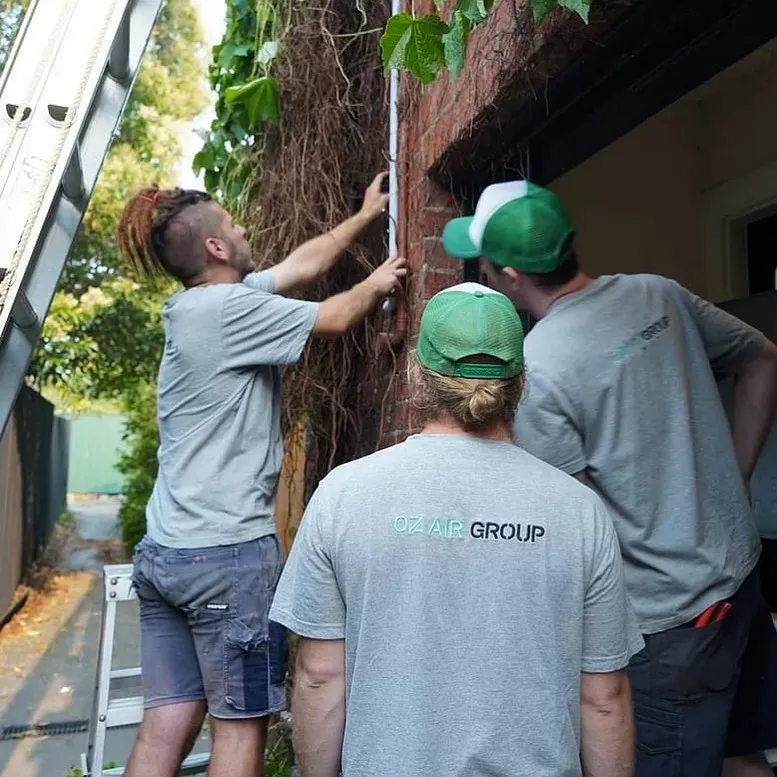





.png)









.png)